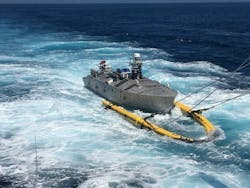Textron to build mine warfare unmanned surface vessel (USV) with high-temperature superconducting magnets
WASHINGTON – U.S. Navy ocean mine warfare experts are asking Textron Systems Corp. in Hunt Valley, Md. to build a counter-mine system for surface warships and uncrewed surface vessels that capitalizes on enabling technologies in high-temperature superconducting magnets.
Officials of the Naval Sea Systems Command in Washington announced an $18 million order to Textron in October for production of the Mine Sweep Payload Delivery Systems (MSPDS). Options could increase this order's value to $106.2 million.
The MSPDS surface counter-mine system locates and detonates acoustic and magnetic influence mines, and capitalizes on experimental Magnetic and Acoustic Generation Next Unmanned Superconducting Sweep (MAGNUSS) technologies, developed by Textron under supervision of the Office of Naval Research in Arlington, Va. MAGNUSS uses a high-temperature superconducting magnet with an advanced acoustic generator.
Uncrewed systems
Textron’s MSPDS mine warfare system reached initial operating capability in 2022. As of October 2023, the company has delivered two pilot systems and four low-rate production crafts and payloads. The Navy use these existing units to support its Littoral Combat Ship operations.
MSPDS is for the Navy's Mine Countermeasures Unmanned Surface Vessel (MCM USV), which will use several payload delivery systems, including the MSPDS, Minehunting Payload Delivery System, and Payload Delivery Systems For Mine Neutralization.
The Navy has been moving the mine countermeasures mission to the Littoral Combat Ship (LCS) as a suite of mission modules like the MCM-USV as a deployable system on the LCS to complete the minesweeping mission.
The advantage of using the MAGNUSS and its high-temperature superconducting magnet aboard an unmanned surface vessel (USV) is the ability to run at very high electrical currents with near-zero resistance, which can sweep magnetic influence mines when coupled to an acoustic generator.
Related: New ship takes lead in counter-mine and anti-submarine warfare
In addition to the recent advancement of high-temperature superconductor magnets to provide a non-towed magnetic source, Navy researchers have been developing a non-towed, underwater acoustic source with low-drag as an alternative to a legacy acoustic generator that still enables additional benefits to the non-towed magnetic source.
Modular systems
The modularity of the high-temperature superconductor magnet and acoustic generator potentially could be deployed on any craft of opportunity -- not just aboard the MCM-USV.
Textron engineers are building a high-temperature superconductor magnet and an acoustic generator; integrating the mechanical, electrical, and command and controls (C2) systems of the two systems with each other; and integrating the complete payload with the MCM-USV and its hull.
On this order, Textron will do the work in Cockeysville and Beltsville, Md.; Naples, Fla.; Houston; Salt Lake City; and Yaphank, N.Y., and should be finished by next fall. For more information contact Textron Systems online at www.textronsystems.com/products/cusv, or Naval Sea Systems Command at www.navsea.navy.mil.
About the Author
John Keller
Editor-in-Chief
John Keller is the Editor-in-Chief, Military & Aerospace Electronics Magazine--provides extensive coverage and analysis of enabling electronics and optoelectronic technologies in military, space and commercial aviation applications. John has been a member of the Military & Aerospace Electronics staff since 1989 and chief editor since 1995.
